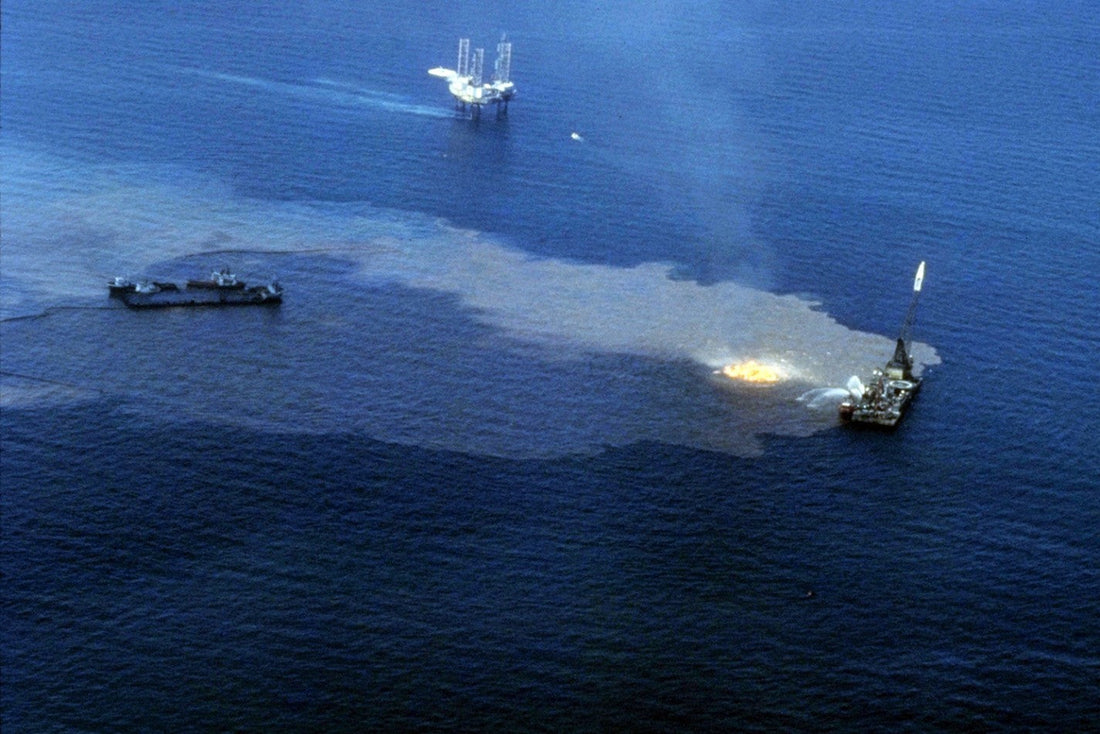Ixtoc I: The Forgotten Disaster Beneath the Gulf
Ashton Routhier
Share
June 3, 1979: The Blowout Begins
In the Bay of Campeche, off the southwestern coast of Mexico, the semi-submersible drilling rig Sedco 135 was hard at work on an exploratory oil well called Ixtoc I. Operated by Pemex, Mexico’s state-owned oil company, the well was part of a growing push to unlock the Gulf of Mexico’s vast fossil fuel reserves.
But early that morning, something went terribly wrong.
While drilling nearly 3,600 meters below the seafloor, the crew lost circulation of drilling mud—a critical barrier meant to control underground pressure. When mud circulation is lost, there’s little to stop oil and gas from rushing up the well column. As the crew attempted to seal the well, a catastrophic sequence of events unfolded.
At 3:30 a.m., the well exploded. Flames engulfed the rig, the Sedco 135 burned, and the structure eventually collapsed, leaving the well spewing oil freely into the ocean.
The Spill That Wouldn’t Stop
For the next 290 days, Ixtoc I leaked an estimated 126 million gallons of crude oil into the Gulf of Mexico, making it the second largest accidental oil spill in marine history, after the 2010 Deepwater Horizon disaster.
At the peak of the spill, oil gushed from the seabed at a rate of 30,000 barrels per day. Pemex attempted to slow the flow by pumping steel, iron, and lead balls into the well—a method that reduced the leak but could not stop it. Two relief wells were drilled to relieve pressure, but oil continued to surge into the Gulf for months.
Chemical dispersants like Corexit 9527 were sprayed over 1,100 square miles of slick, but by today’s environmental standards, these efforts were rudimentary and, at times, counterproductive. In Texas waters, dispersants were banned due to concerns about toxicity and ineffectiveness on weathered oil.
Ultimately, the spill affected 2,800 square kilometers of ocean surface, and 162 miles of U.S. coastline were impacted.
Ecological and Economic Impact
The Ixtoc I spill devastated coastal ecosystems on both sides of the Gulf. Thick black oil washed ashore, sometimes piling up 30 centimeters deep, choking beaches and mangroves.
For Mexico, the most alarming consequence was the contamination of Rancho Nuevo, one of the world’s few nesting sites for the Kemp’s ridley sea turtle, a critically endangered species. Conservation teams scrambled to airlift thousands of hatchlings to cleaner waters, hoping to prevent a collapse of the population. Even with these emergency measures, it took until the late 1980s for Kemp’s ridley turtle numbers to show signs of recovery.
In the U.S., the spill reached Texas beaches by August 1979, giving officials two months to prepare protective booms and skimmers. Despite efforts, 71,500 barrels of oil eventually landed on U.S. shores. Cleanup crews removed more than 10,000 cubic yards of oiled sand and debris, often by hand to avoid further damaging fragile coastal systems.
The impact on crab and mollusk populations was severe. In some areas, the ghost crab population was reduced to nearly zero for months after the spill. Fisheries reported a 50–70% drop in shrimp and octopus catches compared to the previous year. Coastal lagoons and estuaries—nurseries for many fish species—suffered long-term damage, affecting breeding cycles for years.
A Disaster Largely Forgotten
Unlike the Exxon Valdez spill of 1989 or Deepwater Horizon in 2010, the Ixtoc I disaster has faded from public memory. Yet in scale and impact, it remains one of the most significant environmental catastrophes in history.
Several factors contributed to its relative obscurity:
- Media coverage was limited due to geopolitical focus on other global events in 1979.
- The affected region in Mexico was remote and less populated, reducing immediate economic pressure on policymakers.
- Pemex claimed sovereign immunity, spending $100 million on cleanup but avoiding most compensation claims, especially in the U.S.
Furthermore, scientists and governments at the time lacked baseline environmental data, making it difficult to quantify the full extent of the damage. The disaster did, however, spark a wave of marine research in the Gulf of Mexico, laying the groundwork for future oil spill response studies.
Lessons That Echo Today
The Ixtoc I spill shares eerie similarities with the Deepwater Horizon disaster, which occurred 31 years later in the same body of water. Both spills:
- Resulted from a loss of control at the wellhead.
- Featured failed attempts to cap the flow using steel balls, mud, and containment domes.
- Took months to control, allowing millions of gallons of oil to escape into the sea.
The long-term effects of Ixtoc I are still not fully understood. Much of the oil sank to the Gulf floor, creating concerns about benthic (bottom-dwelling) species and long-term sediment contamination. In Texas, studies found no definitive damage to offshore shrimp populations, but the intertidal zones—where crabs, mollusks, and birds thrive—were devastated.
A Turning Point in Environmental Awareness
For the Gulf of Mexico, the Ixtoc I blowout was more than an oil spill—it was a wake-up call. It exposed vulnerabilities in offshore drilling technology, highlighted the lack of international legal frameworks for transboundary pollution, and forced a new era of marine environmental monitoring.
In the words of marine pollution experts at the time:
"Ixtoc I changed the way we look at offshore drilling disasters—not as isolated incidents, but as regional, long-lasting ecological crises."
Today, as energy demands continue to rise and deep-sea drilling expands, the lessons of Ixtoc I remain as urgent as ever.
